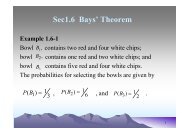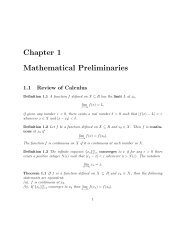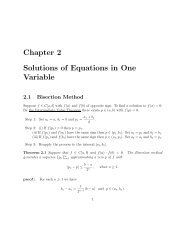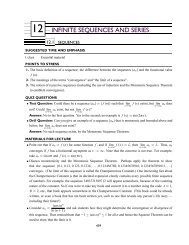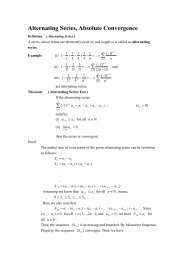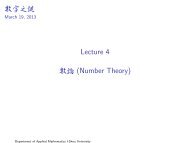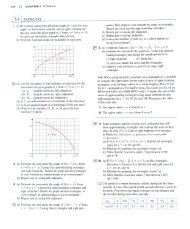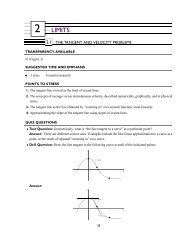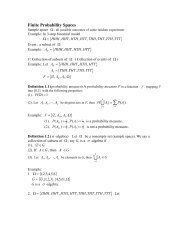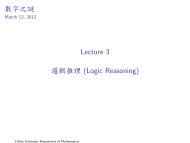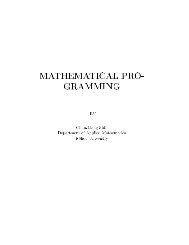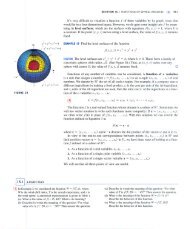[ill x = j .JY (y - 3),
[ill x = j .JY (y - 3),
[ill x = j .JY (y - 3),
Create successful ePaper yourself
Turn your PDF publications into a flip-book with our unique Google optimized e-Paper software.
aEXERCISES<br />
1-4 Set up, but do not evaluate, an integral for the area of the<br />
surface obtained by rotating the curve about (a) the x-axis and<br />
(b) the y-axis.<br />
rn y = x 4 , 0 ~ x ~ I 2. Y = xe-X, I ~ x ~ 3<br />
4.x=~<br />
5-12 Find the area of the surface obtained by rotating the curve<br />
about the x-axis.<br />
W y = x 3 , 0 ~ x ~ 2<br />
6.9x=y2+18, 2~x~6<br />
7. y = J"l""+4X, I ~ X ~ 5<br />
8. y = cos 2x, 0 ~ X ~ 7T16<br />
9. y = cosh x, 0 ~ x ~ I<br />
x 3<br />
I I<br />
10. Y = - + -, :2 ~ x ~ I<br />
6 2x<br />
[IQX=5(y2 + 2)3/2, l~y~2<br />
12.x=I+2y2, l~y~2<br />
=21Tf: ~ du<br />
13-16 The given curve is rotated about the y-axis. Find the area<br />
of the resulting surface.<br />
13. y = {j;, I ~ Y ~ 2<br />
14. Y = I - x 2 , 0 ~ x ~ I<br />
[<strong>ill</strong> x =~, 0 ~ Y ~ al2<br />
16. y = ~X2 - ~ In x, I ~ x ~ 2<br />
= 21T . Hsee () tan () + In 1see () + tan ()11:/4 (by Example 8 in Section 8.2)<br />
= 1T[seea tan a + In(seea + tan a) -.fi -In(.fi + 1)]<br />
s = 1T[e~ + In(e + ~) - .fi - In(.fi + 1)]<br />
17-20 Use Simpson's Rule with n = 10 to approximate the area<br />
of the surface obtained by rotating the curve about the x-axis.<br />
Compare your answer with the value of the integral produced by<br />
your calculator.<br />
[<strong>ill</strong>] 21-22 Use either a CAS or a table of integrals to find the exact<br />
area of the surface obtained by rotating the given curve about the<br />
x-axis.<br />
[<strong>ill</strong>] 23-24 Use a CAS to find the exact area of the surface obtained<br />
by rotating the curve about the y-axis. If your CAS has trouble<br />
evaluating the integral, express the surface area as an integral in<br />
the other variable.<br />
IThJ If the region rzJt = {(x, y) I x:;;' 1, 0 ~ Y ~ llx} is rotated<br />
about the x-axis, the volume of the resulting solid is finite<br />
(see Exercise 63 in Section 8.8). Show that the surface area is<br />
infinite. (The surface is shown in the figure and is known as<br />
Gabriel's horn.)<br />
y



